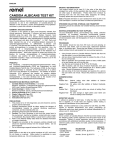Download BactiCard Strep - Thermo Scientific
Transcript
ENGLISH BactiCard® Strep INTENDED USE ® Remel BactiCard Strep is a test kit recommended for use in qualitative procedures for rapid, presumptive identification of streptococci and related genera by detection of leucine aminopeptidase (LAP), pyroglutamyl aminopeptidase (PYR), and esculin hydrolysis (ESC). SUMMARY AND EXPLANATION Esculin hydrolysis has been used for identification of a wide variety of microorganisms, including streptococci. In 1981, Godsey, Schulman, and Eriquez described a test for L-pyrrolidine hydrolysis to identify 1 group A streptococci and enterococci. While investigating methods for identification of streptococci, Fertally and Facklam found Aerococcus strains to be consistently negative for leucine aminopeptidase, while strains of Enterococcus and Streptococcus 2 In 1990, Bosley et al. evaluated 37 gave positive reactions. aerococci and 377 strains representing related genera: streptococci, 3 enterococci, pediococci, lactococci, and leuconostoc. They reported PYR, LAP, and vancomycin susceptibility are three parameters that can be used for differentiating these genera. PRINCIPLE ® BactiCard Strep consists of three separate test circles for LAP, PYR, and ESC. L-Leucine-β-naphthylamide is hydrolyzed by leucine aminopeptidase. L-Pyroglutamyl-β-naphthylamide is hydrolyzed by pyroglutamyl aminopeptidase. Upon hydrolysis, both compounds release β-naphthylamide, which can be detected by the development of a red color after addition of dimethylaminocinnamaldehyde. Esculin (β-glucose-6,7-dihydroxycoumarin) is enzymatically hydrolyzed at the β-glucose linkage to yield esculetin and glucose. Esculetin combines with ferric ions to produce a dark brown to brown-black compound. REAGENTS AND MATERIALS SUPPLIED ® 1. BactiCard Strep Test Cards (25) Reactive Ingredients: L-Leucine-β-naphthylamide (LAP) L-Pyroglutamyl-β-naphthylamide (PYR) Esculin and Ferric Citrate (ESC) 2. Rehydrating Fluid (1 bottle, 6.0 ml) with preservative 3. Color Developer (1 bottle, 6.0 ml) Reactive Ingredient: 0.02% ρ-dimethylaminocinnamaldehyde 4. Applicator Sticks (1 vial) 5. Instructions for Use (IFU) PRODUCT DETERIORATION This product should not be used if (1) the color has changed, (2) the expiration date has passed, or (3) there are other signs of deterioration. SPECIMEN COLLECTION, STORAGE, AND TRANSPORT Specimens should be collected and handled following recommended 4,5 guidelines. MATERIALS REQUIRED BUT NOT SUPPLIED (1) Loop sterilization device, (2) Inoculating loop, swabs, collection containers, (3) Incubators, alternative environmental systems, (4) Supplemental media, (5) Quality control organisms, (6) Vancomycin 30 µg disk (REF R33743), (7) Gram stain reagents, (8) Microscope slides, (9) Microscope, (10) Catalase reagent. PROCEDURE ® Test isolates acceptable for testing with BactiCard Strep are catalase-negative, gram-positive cocci. Remove test isolates from pure, 18-72 hour cultures growing on a nonselective medium. 1. 2. 3. 4. 5. 6. 7. 8. Label a Test Card with the specimen identification. Inoculate only one isolate per Test Card. Add one (1) drop of Rehydrating Fluid to each test circle. Do not oversaturate the test area. Inoculate each test circle with a visible inoculum of the test isolate using an applicator stick (provided). Incubate at room temperature (RT) for ten (10) minutes. Observe the ESC test circle for development of a dark brown or brown-black color, indicating a positive test. Add one (1) drop of Color Developer to the LAP and PYR test circles. Observe test circles for development of a pink to red color within one (1) minute, indicating a positive test. INTERPRETATION LAP Test: Positive Test - Pink to red color Negative Test - No color change PYR Test: Positive Test - Pink to red color Negative Test - No color change ESC Test: Positive Test - Dark brown to brown-black color Negative Test - No color change EXPECTED VALUES 4,6-8 PRECAUTIONS This product is for In Vitro diagnostic use and should be used by properly trained individuals. Precautions should be taken against the dangers of microbiological hazards by properly sterilizing specimens, containers, and media after use. Directions should be read and followed carefully. Caution! 1. Color Developer is toxic and harmful by inhalation, contact with skin, or if swallowed. May impair fertility or cause harm to unborn child. 2. Refer to Material Safety Data Sheet for detailed information on reagent chemicals. STORAGE This product is ready for use and no further preparation is necessary. Store product in its original container at 2-8°C until used. Do not freeze or overheat. A precipitate formed at storage temperatures in the Color Developer is common and does not affect test performance. Allow product to equilibrate to room temperature before use. Once opened, maintain unused test cards at 2-8°C in the foil pouch provided. Seal to protect from moisture. Organism Aerococcus urinae Aerococcus viridans Enterococcus Gemella Globicatella Lactobacillus Lactococcus Leuconostoc Pediococcus Streptococcus (Gp A) Streptococcus (Gp B) Streptococcus (Gp D) Streptococcus (Viridans Gp) Streptococcus pneumoniae PYR – + + + + – b – – – + – – – V Results LAP ESC + – + + – V + V + + + + + + V V + – + V + V V V – + V V VANCO S S a V S S V S R R S S S S S +, most strains positive; -, most strains negative; V, variable; S, susceptible; R, resistant a Vancomycin-resistant strains isolated, but majority of isolates are susceptible b Lactococcus garvieae is PYR positive6 ENGLISH QUALITY CONTROL ® All lot numbers of BactiCard Strep have been tested using the following quality control organisms and have been found to be acceptable. Testing of control organisms should be performed in accordance with established laboratory quality control procedures. If aberrant quality control results are noted, patient results should not be reported. RESULTS PYR LAP ESC BIBLIOGRAPHY 1. 2. 3. 4. CONTROL INCUBATION Enterococcus faecalis ® ATCC 29212 Aerococcus viridans ® ATCC 11563 Pediococcus acidilactici ® ATCC 33314 Aerobic, 10 min. @ RT + + + 5. Aerobic, 10 min. @ RT + – – Aerobic, 10 min. @ RT – + + 6. 7. 8. PERFORMANCE CHARACTERISTICS ® Remel BactiCard Strep was evaluated with 109 strains of streptococci and related genera. Greater than 98% agreement with 9 expected values was obtained. Genus Aerococcus Enterococcus Gemella Lactococcus Leuconostoc Pediococcus Streptococcus No. Tested No. in Agreement 3 23 2 2 5 1 73 3 23 2 2 4* 1 72 *Leuconostoc paramesenteroides ATCC® 33313 is consistently positive for LAP.10 9. 10. Godsey, J., R. Schulman, and L. Eriquez. 1981. Annual Meeting of the American Society for Microbiology. Abstract C84. Fertally, S. and R.R. Facklam. 1987. J. Clin. Microbiol. 25:18451850. Bosley, G.S., P.L. Wallace, C.W. Moss, A.G. Steigerwalt, D.J. Brenner, J.M. Swenson, G.A. Herbert, and R.R. Facklam. 1990. J. Clin. Microbiol. 28:416-421. Murray, P.R., E.J. Baron, J.H. Jorgensen, M.L. Landry, and M.A. Pfaller. 2007. Manual of Clinical Microbiology. 9th ed. ASM Press, Washington, D.C. Forbes, B.A., D.F. Sahm, and A.S. Weissfeld. 2007. Bailey and Scott’s Diagnostic Microbiology. 12th ed. Mosby Elsevier, St. Louis, MO. Facklam, R.R. and J.A. Elliott. 1995. Clin. Microbiol. Rev. 8:479-495. Facklam, R.R. 2001. Clin. Microbiol. Newsl. 23:1-7. Winn, W.C., Jr., S.D. Allen, W.M Janda, E.W. Koneman, G.W. Procop, P.C. Schreckenberger, and G.L. Woods. 2006. Koneman’s Color Atlas and Textbook of Diagnostic Microbiology. 6th ed. Lippincott Williams and Wilkins, Philadelphia, PA. Data on file. Remel Inc., Lenexa, KS. Ruoff, K.L., D.R. Kuritzkes, J.S. Wolfson, and M.J. Ferraro. 1988. J. Clin. Microbiol. 26:2064-2068. PACKAGING ® REF R21112, BactiCard Strep ......................................... 25 Tests/Kit Symbol Legend REF Catalog Number IVD In Vitro Diagnostic Medical Device LAB For Laboratory Use Consult Instructions for Use (IFU) LIMITATIONS 1. Disregard color development in the LAP and PYR test circles that occurs more than 60 seconds after the addition of the Color Developer. 2. False-negative reactions may occur if inadequate inoculum is used or if inoculum is removed from selective media, such as 9 Columbia CNA or PEA agars. 3. This test is only part of the overall scheme for identification of streptococci and related genera. Additional testing may be required for definitive identification. Consult appropriate 4,5,8 references for further instructions. 4. A vancomycin susceptibility screen may be performed to aid in the differentiation of those organisms with overlapping profiles for the enzymes assayed by this test. 5. The test for esculin hydrolysis does not incorporate bile tolerance of the organism and thus, does not directly correlate to results obtained with bile esculin agars or broths. 6. Some enterococcal strains (particularly E. faecalis) produce a pseudocatalase that is responsible for the weak positive catalase reaction that is seen with some strains, particularly on primary isolation. The strength of this reaction may diminish 8 upon subculture. Temperature Limitation (Storage Temp.) LOT Batch Code (Lot Number) Use By (Expiration Date) EC REP European Authorized Representative BactiCard® is a registered trademark of Remel Inc. ATCC® is a registered trademark of American Type Culture Collection. IFU 21112, Revised April 16, 2009 12076 Santa Fe Drive, 2 Lenexa, KS 66215, USA General Information: (800) 255-6730 Technical Services: (800) 447-3641 Order Entry: (800) 447-3635 Local/International Phone: (913) 888-0939 International Fax: (913) 895-4128 Website: www.remel.com Email: [email protected] Printed in U.S.A. FRENCH STOCKAGE Ce produit est prêt à l’emploi, aucune préparation supplémentaire n'est donc nécessaire. Le produit doit être stocké dans son récipient d’origine à une température comprise entre 2 et 8°C jusqu’à utilisation. Ne pas congeler ni surchauffer. Il est courant qu’un précipité se forme aux températures de conservation dans le révélateur chromatique bien qu’il n’affecte pas les performances du test. Attendre que le produit soit à température ambiante avant de l’utiliser. Une fois ouvertes, conserver les cartes de test inutilisées à une température comprise entre 2 et 8°C dans le sachet métallisé fourni. Fermer hermétiquement pour protéger de l’humidité. BactiCard® Strep INDICATION ® Il est recommandé d’utiliser le kit de test BactiCard Strep de Remel lors de procédures d’identification qualitative, rapide et présomptive de streptocoques et de genres associés par détection de la leucine aminopeptidase (LAP), de la pyroglutamyl-aminopeptidase (PYR) et de l’hydrolyse de l’esculine (ESC). DÉTÉRIORATION DU PRODUIT Ce produit ne doit pas être utilisé si (1) sa couleur a changé, (2) la date d’expiration est dépassée ou (3) d’autres signes de détérioration sont visibles. RÉSUMÉ ET EXPLICATION L’hydrolyse de l’esculine a été utilisée à des fins d’identification d’un grand nombre de microorganismes, dont les streptocoques. En 1981, Godsey, Schulman et Eriquez ont décrit un test de l’hydrolyse de la L-pyrrolidine destiné à identifier les streptocoques du groupe A ainsi 1 que les entérocoques. Alors qu'ils recherchaient des méthodes d’identification des streptocoques, Fertally et Facklam découvrirent que les souches d’Aerococcus étaient systématiquement négatives à la leucine aminopeptidase, alors que les souches d’Enterococcus et 2 de Streptococcus présentaient des réactions positives. En 1990, Bosley et al. ont évalué 37 aérocoques et 377 souches représentant des genres associés : streptocoques, entérocoques, pédiocoques, 3 lactocoques et leuconostocs. Ils signalèrent que la sensibilité à la PYR, à la LAP et à la vancomycine sont trois paramètres permettant de différencier ces genres. COLLECTE, STOCKAGE ET TRANSPORT DE PRÉLÈVEMENTS Les prélèvements doivent être collectés et manipulés conformément 4 aux recommandations. MATÉRIEL REQUIS MAIS NON FOURNI (1) Dispositif de stérilisation en boucle, (2) boucle à inoculation, applicateur, récipients de collecte, (3) incubateurs, systèmes environnementaux alternatifs, (4) milieux supplémentaires, (5) organismes de contrôle qualité, (6) disque 30 µg pour vancomycine (REF R33743), (7) colorants de Gram, (8) lamelles de microscope, (9) microscope et (10) catalase. PRINCIPE ® Le kit BactiCard Strep comprend trois cercles de test distincts pour la LAP, le PYR et l’ESC. La L-Leucine-β-naphthylamide est hydrolysée par la leucine aminopeptidase. Le L-Pyroglutamyl-βnaphthylamide est hydrolysé par le pyroglutamyl aminopeptidase. Lors de l’hydrolyse, les deux composés libèrent du β-naphthylamide qui peut être détecté par l'apparition d'une coloration rouge lors de l'ajout de diméthylaminocinnamaldéhyde. L’esculine (β-glucose-6,7dihydroxycoumarine) est hydrolysée de manière enzymatique à la liaison β-glucose afin de produire de l’esculétine et du glucose. L’esculétine s’associe aux ions ferriques pour produire un composé marron foncé à noir. PROCÉDURE ® Les isolats pouvant être testés à l’aide de la BactiCard Strep sont les coques à Gram positif et à catalase négative. Prélever les isolats à tester sur des cultures pures de 18 à 72 heures sur milieu non sélectif. RÉACTIFS ET MATÉRIELS FOURNIS ® 1. Cartes de test BactiCard Strep (par 25) Ingrédients réactifs: L-Leucine-β-naphthylamide (LAP) L-Pyroglutamyl-β-naphthylamide (PYR) Esculine et citrate de fer (ESC) 2. Liquide de réhydratation (1 flacon, 6,0 ml) avec conservateur 3. Révélateur chromatique (1 flacon, 6,0 ml) Ingrédients réactifs: 0,02% de ρ-diméthylaminocinnamaldéhyde 4. Bâtonnets applicateurs (1 flacon) 5. Mode d’emploi (IFU) PRÉCAUTIONS Ce produit exclusivement destiné à une utilisation diagnostique in vitro ne doit être utilisé que par des personnes dûment formées. Toutes les précautions contre les risques microbiens doivent être prises et il est donc indispensable de bien stériliser les prélèvements, les récipients et les milieux après usage. Toutes les instructions doivent être lues attentivement et scrupuleusement respectées. 1. Étiqueter une carte de test avec l'identifiant de l’échantillon. 2. Inoculer un seul isolat par carte de test. 3. Ajouter une (1) goutte de liquide de réhydratation sur chaque cercle de test. Ne pas sursaturer la zone de test. 4. Inoculer chaque cercle de test avec un inoculum visible de l’isolat à tester à l’aide d’un bâtonnet applicateur (fourni). 5. Incuber pendant dix (10) minutes à température ambiante. 6. Si le cercle de test ESC vire au marron foncé ou au marron-noir, le test est positif. 7. Ajouter une (1) goutte de révélateur chromogène sur les cercles de test LAP et PYR. 8. Regarder si les cercles de test virent au rose ou au rouge dans la (1) minute qui suit, ceci indiquant un test positif. INTERPRÉTATION DU TEST Test LAP Test Positif – Couleur rose à rouge Test Négatif – Aucun changement de couleur Test PYR Test Positif – Couleur rose à rouge Test Négatif – Aucun changement de couleur Attention ! 1. Le révélateur chromatique est toxique et nocif par inhalation, contact avec la peau ou ingestion. Peut altérer la fertilité. Risque pendant la grossesse d'effets néfastes pour l'enfant. 2. Se reporter aux fiches signalétiques pour des informations détaillées sur les réactifs chimiques. Test ESC Test Positif – Couleur marron foncé à noir Test Négatif – Aucun changement de couleur 3 FRENCH 3. VALEURS ATTENDUES 4,6-8 Organisme PYR Aerococcus urinae Aerococcus viridans Enterococcus Gemella Globicatella Lactobacillus Lactococcus Leuconostoc Pediococcus Streptococcus (Gp A) Streptococcus (Gp B) Streptococcus (Gp D) Streptococcus (Gp Viridans) Streptococcus pneumoniae – + + + – –b – – + – – – V Résultats LAP ESC + – + – V + V + + + + + + VANCO V V + – + V + V V V – + V V S S Va S S V S R R S S S S S +, la plupart des souches sont positives; –, la plupart des souches sont négatives; V, variables; S, susceptibles; R, résistantes a Les souches résistantes de vancomycine ont été isolées mais la majorité des isolats sont susceptibles. b Lactococcus garvieae est PYR-positif. CONTRÔLE QUALITÉ ® Tous les numéros de lots du kit BactiCard Strep ont été testés avec les organismes de contrôle qualité suivants et reconnus acceptables. Les tests des organismes de contrôle effectués doivent satisfaire aux critères établis pour les procédures de contrôle qualité en laboratoire. En cas de résultats de contrôle qualité aberrants, les résultats des patients ne doivent pas être communiqués. CONTRÔLE Enterococcus faecalis ATCC® 29212 Aerococcus viridans ATCC® 11563 Pediococcus acidilactici ATCC® 33314 INCUBATION Aérobie, 10 min. à température ambiante Aérobie, 10 min. à température ambiante Aérobie, 10 min. à température ambiante RÉSULTATS PYR LAP ESC + + + + – – – + + PERFORMANCES ® Le kit BactiCard Strep de Remel a été évalué avec 109 souches de streptocoques et de genres associés. Les résultats obtenus 9 correspondent à plus de 98 % aux valeurs attendues. Genre Aerococcus Enterococcus Gemella Lactococcus Leuconostoc Pediococcus Streptococcus N° testé N° attendu 3 23 2 2 5 1 73 3 23 2 2 4* 1 72 4. 5. 6. Il ne s'agit là que d'un test faisant partie d'un ensemble de méthodes d’identification des streptocoques et des genres associés. Des tests supplémentaires peuvent s’avérer nécessaires pour confirmer l'identification. Consulter les références bibliographiques correspondantes pour obtenir de 4,5,8 plus amples instructions. Un dépistage de susceptibilité à la vancomycine peut être réalisé pour faciliter la différenciation des organismes présentant des profils de chevauchement pour les enzymes testées au cours de ce test. Le test sur l’hydrolyse de l’esculine n’intègre pas la tolérance à la bile de l’organisme et ne correspond donc pas directement aux résultats obtenus avec des géloses ou des liquides de bileesculine. Certaines souches entérocoques, notamment E. faecalis, produisent une pseudocatalase responsable de la faible réaction catalase-positive constatée pour certaines souches, essentiellement lors d’une isolation primaire. L'intensité de cette 8 réaction peut diminuer avec une sous-culture. BIBLIOGRAPHIE 1. Godsey, J., R. Schulman, and L. Eriquez. 1981. Annual Meeting of the American Society for Microbiology. Abstract C84. 2. Fertally, S. and R. Facklam. 1987. J. Clin. Microbiol. 25:1845-1850. 3. Bosley, G.S., P.L. Wallace, C.W. Moss, A.G. Steigerwalt, D.J. Brenner, J.M. Swenson, G.A. Herbert, and R.R. Facklam. 1990. J. Clin. Microbiol. 28:416-421. 4. Murray, P.R., E.J. Baron, J.H. Jorgensen, M.L. Landry, and M.A. Pfaller. 2007. Manual of Clinical Microbiology. 9th ed. ASM Press, Washington, D.C. 5. Forbes, B.A., D.F. Sahm, and A.S. Weissfeld. 2007. Bailey and Scott’s Diagnostic Microbiology. 12th ed. Mosby Elsevier, St. Louis, MO 6. Facklam, R.R. and J.A. Elliott. 1995. Clin. Microbiol. Rev. 8 :479-495. 7. Facklan, R.R. 2001. Clin. Microbiol. Newsl. 23 :1-7. 8. Winn, W., S. Allen, J. William, E. Koneman, G. Procop, P. Schreckenberger, and G. Woods. 2006. Koneman’s Color Atlas and Textbook of Diagnostic Microbiology. 6th ed. Lippincott Williams and Wilkins, Baltimore, MD. 9. Data on file. Remel Inc., Lenexa, KS. 10. Ruoff, K.L., D.R. Kuritzkes, J.S. Wolfson, and M.J. Ferraro. 1988. J. Clin. Microbiol. 26:2064-2068. CONDITIONNEMENT ® REF R21112, BactiCard Strep ........................................... 25 tests/kit Légendes des symboles REF Numéro de référence IVD Dispositif médical de diagnostic in vitro LAB Pour l’usage de laboratoire Lire les instructions avant utilisation (IFU = mode d’emploi) Limites de température (stockage) LOT Code de lot (numéro) À utiliser avant le (date de péremption) EC REP Représentant autorisé pour l'UE *Leuconostoc paramesenteroides ATCC® 33313 est régulièrement testé LAP- positif.10 LIMITATIONS 1. Ne pas tenir compte du changement de couleur dans les cercles de test LAP et PYR apparaissant plus de 60 secondes après l’ajout du révélateur chromogène. 2. Des faux négatifs peuvent se produire si un inoculum inadéquat a été utilisé ou si l’inoculum est prélevé sur un milieu sélectif, tel 9 que les géloses Columbia CNA ou PEA. BactiCard® est une marque déposée de Remel Inc. ® ATCC est une marque déposée d’American Type Culture Collection. IFU 21112, révisé le 2009-04-16 Imprimé aux Etats-Unis 12076 Santa Fe Drive, Lenexa, KS 66215, États-Unis Renseignements : (800) 255-6730 Service technique : (800) 447-3641 Service commercial : (800) 447-3635 (États-Unis) Téléphone (international) : +1 (913) 888-0939 Télécopie (international) : +1 (913) 895-4128 Site Web : www.remel.com E-mail : [email protected] GERMAN PRODUKTSCHÄDEN Dieses Produkt sollte nicht verwendet werden, falls (1) eine Farbänderung eingetreten ist, (2) das Verfallsdatum abgelaufen ist, sowie (3) bei anderen Anzeichen von Beschädigung. BactiCard® Strep PROBENENTNAHME, LAGERUNG UND TRANSPORT Die Proben sollten entsprechend der folgenden Richtlinien entnommen werden.4 ANWENDUNGSBEREICH Bei Remel BactiCard® Strep handelt es sich um ein für qualitative Verfahren empfohlenes Test-Kit für rasche Identifikation bei Verdacht auf Streptokokken und verwandte Mikroorganismen durch Nachweis von Leukinaminopeptidase (LAP), Pyroglutamylaminopeptidase (PYR) und Aesculinhydrolyse (ESC). ERFORDERLICHE MATERIALIEN, DIE NICHT IM LIEFERUMFANG ENTHALTEN SIND (1) Gerät zur Sterilisierung der Inokulationsschlinge, (2) Inokulationsschlinge, Abstrichtupfer, Sammelbehälter, (3) Inkubatoren, alternative Umweltsysteme, (4) zusätzliche Medien, (5) Organismen zur Qualitätskontrolle, (6) Vancomycin 30 µg (REF R33743), (7) GramFärbereagenzien, (8) Mikroskop-Objektträger, (9) Mikroskop und (10) Katalase-Reagenz. ZUSAMMENFASSUNG UND ERKLÄRUNG Aesculinhydrolyse wird zur Identifikation für zahlreiche unterschiedliche Mikroorganismen verwendet, darunter auch Streptokokken. 1981 beschrieben Godsey, Schulman und Eriquez einen Test für die Identifikation von Gruppe-A-Streptokokken und -Enterokokken mittels LPyrrolidin-Hydrolyse.1 Bei der Untersuchung von Verfahren zur Identifikation von Streptokokken stellten Fertally und Facklam fest, dass Aerococcus-Stämme durchgehend negative Reaktionen auf Leuzinaminopeptidase aufwiesen, jedoch Enterococcus- und StreptococcusStämme positive Reaktionen zeigten.2 1990 werteten Bosley et al. 37 Aerokokken und 377 Stämme aus, die zu verwandten Mikroorganismen gehören: Streptokokken, Enterokokken, Pediokokken, Laktokokken und Leukonostoc.3 Gemäß dieser Auswertung sind PYR-, LAP- und Vancomycin-Resistenz drei Parameter für die Differenzierung dieser Mikroorganismen. VERFAHREN Für Tests mit BactiCard® Strep geeignete Isolate sind Katalase-negative, grampositive Kokken. Testisolate sind Reinkulturen zu entnehmen, die über einen Zeitraum von 18 bis 72 Stunden auf einem nicht-selektiven Medium gewachsen sind. 1. Testkarte mit einer Probenkennung etikettieren. 2. Nur ein Isolat pro Testkarte inokulieren. 3. Auf jede Testvertiefung einen (1) Tropfen Rehydrierungs-flüssigkeit geben. Den Testbereich nicht übersättigen. TESTPRINZIP Das BactiCard® Strep-Kit besteht aus drei separaten Testzyklen für LAP, PYR und ESC. L-Leucin-β-Naphthylamid wird durch Leuzinaminopeptidase hydrolisiert. L-Pyroglutamyl-β-Naphthylamid wird durch Pyroglutamyl-Aminopeptidase hydrolisiert. Bei der Hydrolyse setzen beide Verbindungen β-Naphthylamid frei, das durch eine rote Farbentwicklung bei der Zugabe von Dimethyl-Aminocinnamaldehyd nachgewiesen werden kann. Esculin (β-Glucose-6,7-Dihydroxy-coumarin) wird enzymatisch mit der β-Glucose-Verbindung hydrolisiert, um Esculetin und Glucose bereitzustellen. Esculetin bindet mit Ferro-Ionen und bildet ein dunkelbraune bis braunschwarze Verbindung. 4. In die einzelnen Testvertiefungen mittels Applikatorstäbchen (im Test-Kit enthalten) ein sichtbares Inokulum geben. 5. Bei Raumtemperatur (RT) 10 Minuten inkubieren. 6. Die ESC-Testvertiefung auf Entwicklung einer dunkelbraunen oder schwarzbraunen Färbung prüfen (Hinweis auf positiven Test). 7. In die LAP- und PYR-Testvertiefungen Farbentwickler geben. 8. Die Testvertiefungen auf Entwicklung einer rosa bis roten Färbung innerhalb einer (1) Minute prüfen (Hinweis auf positiven Test). IM LIEFERUMFANG ENTHALTENE REAGENZIEN UND MATERIALIEN 1. BactiCard® Strep Testkarten (25) Reaktive Inhaltstoffe: L-Leuzin-β-Naphthylamid (LAP) L-Pyroglutamyl-β-Naphthylamid (PYR) Esculin; Ferrocitrate (ESC) 2. Rehydrierungsflüssigkeit (1 Flasche, 6,0 ml) Konservierungsmittel 3. Farbentwickler (1 Flasche, 6,0 ml) Reaktiver Inhaltstoff: 0,02% ρ-dimethylaminocinnamaldehyd 4. Abstrichtupfer (1 Phiole) 5. Gebrauchsanweisung (IFU) INTERPRETATION DES TESTS LAP Test Positiver Test – Rosa bis rote Farbe Negativer Test – Keine Farbänderung einen (1) Tropfen PYR Test Positiver Test – Rosa bis rote Farbe Negativer Test – Keine Farbänderung ESC Test Positiver Test – Dunkelbraune bis braunschwarze Farbe Negativer Test – Keine Farbänderung Organismus VORSICHTSMASSNAHMEN Dieses Produkt ist für die Verwendung in der In-Vitro-Diagnostik bestimmt und sollte nur von entsprechend geschulten Personen verwendet werden. Es sind Vorsichtsmaßnahmen gegen die von mikrobiologischen Materialien ausgehenden Gefahren zu ergreifen, indem Proben, Container und Medien nach Gebrauch ordnungsgemäß sterilisiert werden. Die Gebrauchsanweisung muss sorgfältig gelesen und befolgt werden. Aerococcus urinae Aerococcus viridans Enterococcus Gemella Globicatella Lactobacillus Lactococcus Leuconostoc Pediococcus Streptococcus (Gp A) Streptococcus (Gp B) Streptococcus (Gp D) Streptococcus (Viridans Gp) Streptococcus pneumoniae Achtung! 1. Der Farbentwickler ist toxisch und gesundheitsschädigend bei Inhalation, bei Kontakt mit Haut oder Augen oder bei Verschlucken. Kann die Fruchtbarkeit beeinträchtigen oder ungeborene Säuglinge schädigen. 2. Für genaue Angaben zur chemischen Zusammensetzung der Reagenzien siehe das Datenblatt für Materialsicherheit. LAGERUNG Keine weitere Vorbereitung erforderlich. Das Produkt bis zur Verwendung in seiner Originalverpackung bei 2 - 8°C aufbewahren. Nicht einfrieren oder überhitzen. Bei Lagertemperaturen gebildete Ablagerungen im Farbentwickler ist normal und wirkt sich nicht auf die Testergebnisses aus. Vor Verwendung auf Zimmertemperatur erwärmen lassen. Nach dem Öffnen nicht verwendete Testkarten bei 2 - 8°C in der mitgelieferten Folienverpackung belassen. Zum Schutz vor Feuchtigkeit versiegeln. PYR – + + + V – –b – – + – – – V Ergebnisse4,6-8 LAP ESC VANCO + – + V – V + V + + + + + + V V + – + V + V V V – + V V S S Va S S V S R R S S S S S +, die meisten Stränge positiv; –, die meisten Stränge negativ; V, Variable; S, Empfänglichkeit; R, resistent a Vancomycin-resistente Stränge wurden isoliert, aber die Mehrheit der Isolate sind empfänglich b Lactococcus garvieae ist PYR-positiv 5 GERMAN QUALITÄTSKONTROLLE Alle Chargen-Nummern des BactiCard® Strep-Kit wurden unter Verwendung der nachfolgend aufgeführten Organismen zur Qualitätskontrolle getestet und als tauglich befunden. Das Testen von Kontrollorganismen sollte nach den üblichen Qualitätskontrollverfahren für Labore durchgeführt werden. Falls anomale Qualitätskontrollresultate festzustellen sind, sollten die Patientenresultate nicht in den Bericht aufgenommen werden. KONTROLLE INKUBATION Enterococcus faecalis ATCC® 29212 Aerococcus viridans ATCC® 11563 Pediococcus acidilactici ATCC® 33314 Aerob, 10 Min. bei Raumtemperatur Aerob, 10 Min. bei Raumtemperatur Aerob, 10 Min. bei Raumtemperatur ERGEBNISSE PYR LAP ESC + + + + – – – + + Aerococcus Enterococcus Gemella Lactococcus Leuconostoc Pediococcus Streptococcus Einige Enterokokken-Stränge (besonders E. faecalis) produzieren eine Pseudokatalase, die für die schwach positive Katalase-Reaktion verantwortlich ist, die bei einigen Strängen, besonders bei der primären Isolierung, zu beobachten ist. Die Stärke dieser Reaktion kann bei Anlegen einer Subkultur abnehmen.8 LITERATURVERWEISE 1. 2. 3. 4. LEISTUNGSMERKMALE Das BactiCard® Strep-Kit von Remel wurde mit 109 Strängen von Streptokokken und verwandten Genera ausgewertet. Es wurde eine größer als 98 % Übereinstimmung mit den erwarteten Werten erzielt.9 Genus 6. Anzahl getestet Anzahl in Übereinstimmung 3 23 2 2 5 1 73 3 23 2 2 4* 1 72 *Leuconostoc paramesenteroides ATCC® 33313 ist konsistent positiv für LAP.10 BESCHRÄNKUNGEN 1. Farbentwicklungen in den LAP- und PYR-Testvertiefungen ignorieren, die mehr als 60 Sekunden nach Hinzufügen des Farbentwicklers auftreten. 2. Bei Verwendung eines ungeeigneten oder aus selektiven Medien wie beispielsweise Columbia-CNA- oder PEA-Agar entnommenen Inokulums ist mit falsch negativen Reaktionen zu rechnen.9 3. Dieser Test stellt nur einen Teil des Gesamtschemas zur Identifikation von Streptokokken und verwandten Mikroorganismen dar. Zur endgültigen Identifikation sind u. U. weitere Tests erforderlich. Weitere Anweisungen sind der entsprechenden Dokumentation zu entnehmen.4,5,8 4. Ein Test auf Vancomycin-Empfindlichkeit kann ausgeführt werden, um die Differenzierung derjenigen Organismen zu unterstützen, die überschneidende Profile für die durch diesen Test abgedeckten Enzyme aufweisen. 5. Der Test auf Esculin-Hydrolyse berücksichtigt nicht die Gallentoleranz des Organismus und korreliert daher nicht direkt mit den Ergebnissen, die mit Gallen-Esculin-Agaren oder Nährböden erzielt wurden. 5. 6. 7. 8. 9. 10. Godsey, J., R. Schulman, and L. Eriquez. 1981. Annual Meeting of the American Society for Microbiology. Abstract C84. Fertally, S. and R. Facklam. 1987. J. Clin. Microbiol. 25:1845-1850. Bosley, G.S., P.L. Wallace, C.W. Moss, A.G. Steigerwalt, D.J. Brenner, J.M. Swenson, G.A. Herbert, and R.R. Facklam. 1990. J. Clin. Microbiol. 28:416-421. Murray, P.R., E.J. Baron, J.H. Jorgensen, M.L. Landry, and M.A. Pfaller. 2007. Manual of Clinical Microbiology. 9th ed. ASM Press, Washington, D.C. Forbes, B.A., D.F. Sahm, and A.S. Weissfeld. 2007. Bailey and Scott’s Diagnostic Microbiology. 12th ed. Mosby Elsevier, St. Louis, MO Facklam, R.R. and J.A. Elliott. 1995. Clin. Microbiol. Rev. 8 :479-495. Facklan, R.R. 2001. Clin. Microbiol. Newsl. 23 :1-7. Winn, W., S. Allen, J. William, E. Koneman, G. Procop, P. Schreckenberger, and G. Woods. 2006. Koneman’s Color Atlas and Textbook of Diagnostic Microbiology. 6th ed. Lippincott Williams and Wilkins, Baltimore, MD. Data on file. Remel Inc., Lenexa, KS. Ruoff, K.L., D.R. Kuritzkes, J.S. Wolfson, and M.J. Ferraro. 1988. J. Clin. Microbiol. 26:2064-2068. PACKUNGSINHALT REF R21112, BactiCard® Strep ................................................ 25 Tests/Kit Verwendete Symbole REF Katalog-Nr. IVD Medizinprodukt für die In-vitro-Diagnostik LAB Für Laborgebrauch Gebrauchsanweisung beachten Temperatureinschränkungen (Lagertemp.) LOT Chargenbezeichnung (Chargen-Nr.) Zu verwenden bis (Verfallsdatum) EC REP Autorisierte Vertretung für U-Länder BactiCard® ist eine eingetragenes Warenzeichen von Remel Inc. ATCC® ist ein eingetragenes Warenzeichen von American Type Culture Collection. IFU 21112. Revidierte Fassung vom 2009-04-16 12076 Santa Fe Drive, Lenexa, KS 66215, USA Allgemeine Auskünfte: (800) 255-6730 Technische Unterstützung: (800) 447-3641 Bestellungen: (800) 447-3635 Telefon lokal/international: (913) 888-0939 Fax international: (913) 895-4128 Website: www.remel.com E-Mail: [email protected] Printed in U.S.A. ITALIAN CONSERVAZIONE Questo prodotto è pronto per l’uso e non richiede ulteriore preparazione. Conservare il prodotto nell’apposita confezione a una temperatura compresa tra 2 e 8 °C fino al momento dell’uso. Non congelare e non surriscaldare. Alle temperature di conservazione nel contenitore del rilevatore di colore si può formare un precipitato. Si tratta di un fenomeno normale che non influenza le prestazioni del test. Prima dell’uso portare il prodotto a temperatura ambiente. Non incubare prima dell’uso. Una volta aperta la confezione, conservare i cartoncini di reazione non utilizzati a 2-8 °C nell’apposita busta metallizata fornita in dotazione. Sigillare per proteggere dall’umidità. BactiCard® Strep USO PREVISTO ® Remel BactiCard Strep è un kit per test raccomandato per l'uso con le procedure qualitative per la determinazione rapida presunta degli streptococchi e dei generi correlati mediante il rilevamento di leucina aminopeptidasi (LAP), piroglutamil-aminopeptidasi (PYR) e idrolisi dell'esculina (ESC). DETERIORAMENTO DEL PRODOTTO Questo prodotto non deve essere utilizzato se (1) il colore è cambiato, (2) è trascorsa la data di scadenza o (3) sono presenti altri segni di deterioramento. DESCRIZIONE DEL PRODOTTO L'idrolisi dell'esculina è stata usata per l'identificazione di un'ampia gamma di microrganismi, compresi gli streptococchi. Nel 1981, Godsey, Schulman ed Eriquez hanno descritto un test di idrolisi della L-pirrolidina usato per identificare gli streptococchi del gruppo A e gli 1 enterococchi. Durante la ricerca di metodi per l'identificazione degli streptococchi, Fertally e Facklam hanno rilevato che i ceppi di Aerococcus erano uniformemente negativi alla leucina aminopeptidasi, mentre i ceppi di Enterococcus e Streptococcus 2 reagivano positivamente. Nel 1990, Bosley et al. hanno esaminato 37 aerococchi e 377 ceppi rappresentativi di generi correlati: 3 streptococchi, enterococchi, pediococchi, lattococchi e leuconostoc. Nello studio è stato riportato che la risposta a PYR, LAP e la suscettibilità alla vancomicina erano tre parametri utilizzabili per differenziare questi generi. RACCOLTA, CONSERVAZIONE E TRASPORTO DEI CAMPIONI 4 Raccogliere e trattare i campioni seguendole linee guida consigliate. MATERIALI RICHIESTI MA NON FORNITI (1) Dispositivo di sterilizzazione per anse, (2) ansa per inoculo, tampone, contenitori di raccolta, (3) termostati, sistemi per la generazione di atmosfere modificate, (4) terreni supplementari, (5) microrganismi per il controllo qualità, (6) di vancomicina 30 µg (REF R33743), (7) reagenti per la colorazione di Gram, (8) vetrini da microscopio, (9) microscopio e (10) reagente per la catalasi. PROCEDIMENTO ® I campioni isolati di test accettabili per i test con BactiCard Strep comprendono cocchi gram-positivi negativi alla catalasi. Rimuovere gli isolati di test da colture pure di 18-72 ore coltivate su terreno non selettivo. PRINCIPIO ® Il kit BactiCard Strep è costituito da tre aree test separate per la LAP, PYR e ESC. La leucocina aminopeptidasi idrolizza la L-leucinaβ-naftilamide. La piroglutamil aminopeptidasi idrolizza la Lpiroglutamil-β-naftilamide. In seguito a idrolisi i due composti liberano β-naftilamide, che può essere rilevata mediante lo sviluppo della colorazione rossa dopo aver aggiunto dimetil-aminocinnamaldeide. L’esculina (β-glucosio-6,7-diidrossicumarina), in seguito a idrolisi enzimatica con rottura del legame β-glucosio, viene scissa in esculetina e glucosio. L’esculetina si combina con gli ioni di ferro e produce una sostanza che può essere da marrone scuro a marrone-nero. REAGENTI E MATERIALI FORNITI ® 1. Cartoncini reattivi BactiCard Strep (25) Componenti reattivi: L-leucina-β-naftilamide (LAP) L-piroglutamil-β-naftilamide (PYR) Esculina e citrato ferrico (ESC) 2. Fluido di reidratazione (1 flacone 6,0 ml) con conservanti 3. Rilevatore di colore (1 flacone 6,0 ml) Ingrediente reattivo: ρ-dimetilaminocinnamaldeide 0,02% 4. Applicatori stick (1 fiala) 5. Istruzioni per l’uso (IFU) 1. Etichettare un cartoncino di test con l’identificativo del campione. 2. Inoculare un solo campione isolato per ciascun cartoncino di test. 3. Aggiungere una (1) goccia di fluido reidratante entro ciascun anello test. Non saturare eccessivamente l'area di test. 4. Inoculare in ciascun anello test un unico inoculo visibile del campione isolato per il test, utilizzando un bastoncino applicatore (fornito in dotazione). 5. Incubare a temperatura ambiente (RT) per dieci (10) minuti. 6. Controllare se l'anello test ESC si colora di marrone scuro o marrone-nero, ad indicare che il test è positivo. 7. Aggiungere una (1) goccia di sviluppatore cromatico agli anelli test LAP e PYR. 8. Controllare se gli anelli test si colorano di rosa-rosso entro un (1) minuto, ad indicare che il test è positivo. INTERPRETAZIONE DEL TEST Test LAP Test Positivo – Il colore rosa vira a rosso Test Negativo – Nessuna variazione di colore PRECAUZIONI Questo prodotto è indicato per uso diagnostico in vitro e deve essere utilizzato da operatori adeguatamente preparati. Si consiglia di adottare le opportune precauzioni contro eventuali rischi microbiologici, sterilizzando in modo adeguato i campioni, i contenitori e i terreni dopo l’uso. Leggere e seguire attentamente le istruzioni. Test PYR Test Positivo – Il colore rosa vira a rosso Test Negativo – Nessuna variazione di colore Attenzione 1. Il rilevatore di colore è tossico e dannoso se inalato, ingerito o se viene a contatto con la pelle. Può alterare la fertilità o causare danni al feto. 2. Per informazioni dettagliate sui reagenti chimici fare riferimento alle relative Schede di sicurezza. Test ESC Test Positivo – Colorazione marrone scuro o marrone nero Test Negativo – Nessuna variazione di colore 7 ITALIAN 3. VALORI ATTESI Questo test è solo una parte dello schema complessivo per l'identificazione degli streptococchi e dei generi correlati. Potrebbero essere necessari ulteriori test per l'identificazione definitiva. Consultare i riferimenti appropriati per ulteriori 4,5,8 istruzioni . Eseguire un esame di suscettibilità alla vancomicina per favorire la differenziazione di questi microrganismi con profili di sovrapposizione per gli enzimi esaminati. L’esame per l’idrolisi dell’esculina non comprende il test della tolleranza alla bile del microrganismo e quindi non è possibile mettere in relazione questi risultati a quelli ottenuti con agar bile esculina o brodo. Alcuni ceppi di enterococco (in modo particolare E. faecalis) producono una pseudocatalasi responsabile di una catalasi debolmente positiva osservata con alcuni ceppi, in modo particolare provenienti da isolamento primario. È possibile che la 8 forza di questa reazione diminuisca in seguito a subcoltura. 4,6-8 Microrganismi PYR – + + + Aerococcus urinae Aerococcus viridans Enterococcus Gemella Globicatella Lactobacillus Lactococcus Leuconostoc Pediococcus Streptococcus (Gp A) Streptococcus (Gp B) Streptococcus (Gp D) Streptococcus (Viridans Gp) Streptococcus pneumoniae – –b – – + – – – V Risultati LAP ESC + – + VANCO V V + – + V + V V V – + V V – V + V + + + + + + F S Va S S V S R R S S S S S 4. 5. 6. BIBLIOGRAFIA 1. +, la maggior parte dei ceppi è positiva; –, la maggior parte dei ceppi è negativa; V, variabile; S, suscettibile; R, resistente a Ceppi isolati vancomicina resistenti, ma la maggior parte degli isolati sono suscettibili b Lactococcus garvieae e PYR positivo 2. CONTROLLO QUALITÀ ® Prima di essere rilasciati sul mercato, tutti i lotti del kit BactiCard Strep sono stati sottoposti a controllo di qualità utilizzando i microrganismi di seguito elencati e sono risultati accettabili. Il controllo di qualità deve essere effettuato in conformità alle procedure stabilite dal laboratorio. Se il test di controllo qualità fornisce risultati aberranti, i risultati ottenuti con i campioni clinici non devono essere refertati. 4. RESULTATI PYR LAP ESC CONTROLLO INCUBAZIONE Enterococcus faecalis ATCC® 29212 Aerococcus viridans ATCC® 11563 Pediococcus acidilactici ATCC® 33314 Atmosfera aerobia, 10 min. a temperatura ambiente Atmosfera aerobia, 10 min. a temperatura ambiente Atmosfera aerobia, 10 min. a temperatura ambiente + + + + – – – + + CARATTERISTICHE DELLE PRESTAZIONI ® Il kit BactiCard Strep è stato valutato con 109 ceppi di streptococchi e generi correlati. Si è ottenuta una corrispondenza superiore al 98% 9 rispetto ai valori attesi. Genere Aerococcus Enterococcus Gemella Lactococcus Leuconostoc Pediococcus Streptococcus N. di microrganismi testati N. di corrispondenze 3 23 2 2 5 1 73 3 23 2 2 4* 1 72 3. 5. 6. 7. 8. 9. 10. Godsey, J., R. Schulman, and L. Eriquez. 1981. Annual Meeting of the American Society for Microbiology. Abstract C84. Fertally, S. and R.R. Facklam. 1987. J. Clin. Microbiol. 25:18451850. Bosley, G.S., P.L. Wallace, C.W. Moss, A.G. Steigerwalt, D.J. Brenner, J.M. Swenson, G.A. Herbert, and R.R. Facklam. 1990. J. Clin. Microbiol. 28:416-421. Murray, P.R., E.J. Baron, J.H. Jorgensen, M.L. Landry, and M.A. Pfaller. 2007. Manual of Clinical Microbiology. 9th ed. ASM Press, Washington, D.C. Forbes, B.A., D.F. Sahm, and A.S. Weissfeld. 2007. Bailey and Scott’s Diagnostic Microbiology. 12th ed. Mosby Elsevier, St. Louis, MO. Facklam, R.R. and J.A. Elliott. 1995. Clin. Microbiol. Rev. 8:479-495. Facklam, R.R. 2001. Clin. Microbiol. Newsl. 23:1-7. Winn, W.C., Jr., S.D. Allen, W.M Janda, E.W. Koneman, G.W. Procop, P.C. Schreckenberger, and G.L. Woods. 2006. Koneman’s Color Atlas and Textbook of Diagnostic Microbiology. 6th ed. Lippincott Williams and Wilkins, Philadelphia, PA. Data on file. Remel Inc., Lenexa, KS. Ruoff, K.L., D.R. Kuritzkes, J.S. Wolfson, and M.J. Ferraro. 1988. J. Clin. Microbiol. 26:2064-2068. CONFEZIONE ® REF R21112, BactiCard Strep ............................................ 25 test/Kit Legenda dei simboli REF N. di catalogo IVD Dispositivo medico per uso diagnostico in vitro LAB Per uso del laboratorio Consultare le istruzioni per l’uso (IFU) Limitazioni per la temperatura (temp. Di conservazione) LOT Codice lotto (numero di lotto) Da utilizzare entro (data di scadenza) EC REP Rappresentante autorizzato per l'Europa *Leuconostoc paramesenteroides ATCC® 33313 è sempre positivo per la LAP.10 LIMITAZIONI 1. Ignorare la colorazione degli anelli test LAP e PYR che si sviluppa oltre 60 secondi dopo l'aggiunta dello sviluppatore cromatico. 2. È possibile che si verifichino reazioni falso-positive, se si utilizza un inoculo inadeguato o se l'inoculo viene rimosso da terreni 9 selettivi, come gli agar Columbia CNA o PEA. BactiCard® è un marchio di fabbrica registrato di Remel Inc. ATCC® è un marchio di fabbrica registrato di American Type Culture Collection. IFU 21112, data dell’ultima revisione 2009-04-16 12076 Santa Fe Drive, Lenexa, KS 66215, USA Informazioni generali: (800) 255-6730 Assistenza tecnica: (800) 447-3641 Ufficio vendite: (800) 447-3635 Tel. locali/internazionali: (913) 888-0939 Fax internazionale: (913) 895-4128 Sito web: www.remel.com E-Mail: [email protected] Stampato negli USA. SPANISH ALMACENAMIENTO Este producto está listo para su uso y no requiere preparación adicional. El producto debe almacenarse en su envase original a 28°C hasta su uso. No congelar ni sobrecalentar. Es común que se forme un precipitado en el reactivo de desarrollo de color a las temperaturas de almacenamiento, pero esto no afecta el rendimiento del ensayo. Dejar estabilizar el producto a temperatura ambiente antes de su uso. No incubar antes de su uso. Una vez abiertas, mantener las placas de ensayo no utilizadas a una temperatura de 28°C en la bolsa de lámina de aluminio suministrada Sellar la bolsa para proteger el contenido de la humedad. BactiCard® Strep USO PREVISTO ® Remel BactiCard Strep es un kit de ensayo recomendado para su uso en procedimientos cualitativos para la identificación rápida no definitiva de estreptococos y géneros relacionados mediante la detección de la leucina aminopeptidasa (LAP), piroglutamil aminopeptidasa (PYR) e hidrólisis de esculina (ESC). DETERIORO DEL PRODUCTO Este producto no se debe utilizar si (1) el color ha cambiado, (2) se ha sobrepasado la fecha de caducidad o (3) hay otros signos de deterioro. RESUMEN Y EXPLICACIÓN La hidrólisis de esculina se ha utilizado para la identificación de una amplia variedad de microorganismos, como los estreptococos. En 1981, Godsey, Schulman y Eriquez describieron un ensayo para la hidrólisis de L-pirrolidina para identificar estreptococos y enterococos 1 del grupo A. Al investigar posibles métodos para identificar los estreptococos, Fertally y Facklam descubrieron que las cepas de Aerococcus eran siempre negativas para la leucina aminopeptidasa, mientras que las cepas de Enterococcus y Streptococcus reportaban 2 resultados positivos. En 1990, Bosley et al. evaluaron 37 aerococos y 377 cepas que representaban a géneros relacionados: estreptococos, enterococos, pediococos, lactococos y 3 leuconostocos. Indicaron que la susceptibilidad de PYR, LAP y vancomicina son tres parámetros que pueden utilizarse para distinguir entre estos géneros. OBTENCIÓN, ALMACENAMIENTO Y TRANSPORTE DE LAS MUESTRAS Las muestras se deben usar y manipular de acuerdo con las 4 directivas recomendadas. MATERIALES NECESARIOS PERO NO SUMINISTRADOS (1) Asa para esterilización, (2) Asa de inoculación, torunda, envases para recogidas, (3) Incubadoras, sistemas ambientales alternativos, (4) Medios complementarios, (5) Microorganismos de control de calidad, (6) Vancomicina disco de 30 µg (REF R33743), (7) Reactivos para tinción de Gram, (8) Portaobjetos para microscopio, (9) Microscopio y (10) Reactivo catalasa. PRINCIPIO DEL ENSAYO ® El kit BactiCard Strep consta de tres círculos de ensayo separados para LAP, PYR y ESC. El compuesto L-leucina-β-naftilamida es hidrolizado por la leucina aminopeptidasa. El compuesto LPiroglutamil-β-naftilamida es hidrolizado por el piroglutamil aminopeptidasa. Durante la hidrólisis, ambos compuestos liberan βnaftilamida, que puede detectarse cuando la muestra toma un color rojo al añadirse dimetil-aminocinamaldehído. La esculina (β-glucosa6,7-dihidroxicumarina) es hidrolizada enzimáticamente en el enlace β-glucosa para dar esculetina y glucosa. La esculetina se combina con iones férricos para producir un compuesto marrón oscuro a marrón-negro. PROCEDIMIENTO ® Los aislamientos aceptables para los ensayos con BactiCard Strep son cocos catalasa negativos y grampositivos. Retire los aislamientos de ensayo de los cultivos puros de 18 a 72 horas de un medio no selectivo. 1. REACTIVOS Y MATERIAL SUMINISTRADO ® 1. Tarjetas de prueba BactiCard Strep (25) Ingredientes de los reactivos: L-Leucina-β-naftilamida (LAP) L-Piroglutamil-β-naftilamida (PYR) Esculina y citrato férrico (ESC) 2. Líquido rehidratante (1 frasco, 6,0 ml) con conservante 3. Desarrollador de color (1 frasco, 6,0 ml) Ingrediente del reactivo: ρ-dimetilaminocinamaldehído al 0,02% 4. Varillas aplicadoras (1 vial) 5. Instrucciones de uso (IFU) Etiquete una tarjeta de ensayo con la identificación de la muestra. 2. Inocule sólo un aislamiento por tarjeta de ensayo. 3. Añada una (1) gota de líquido rehidratante a cada círculo de ensayo. No sature en exceso la zona de ensayo. 4. Inocule cada círculo de ensayo con un inóculo visible del aislamiento de ensayo mediante una varilla aplicadora (suministrada). 5. Incube a temperatura ambiente durante (10) minutos. 6. Observe el círculo de ensayo de ESC para ver si se desarrolla un color marrón oscuro o marrón-negro, lo que indica que se trata de un ensayo positivo. 7. Añada una (1) gota de Revelador de color a los círculos de ensayo de LAP y PYR. 8. Observe los círculos de ensayo para ver si desarrolla un color de rosa a rojo en un (1) minuto, lo que indica que se trata de un ensayo positivo. PRECAUCIONES Este producto es para uso diagnóstico in vitro y debe ser utilizado por personal con la formación adecuada. Se tomarán precauciones frente a los riesgos microbiológicos esterilizando correctamente las muestras, envases y medios después de su uso. Se deben leer y seguir atentamente las instrucciones. INTERPRETACIÓN DE LOS RESULTADOS Ensayo LAP: Resultado Positivo - Cambio de color de rosa a rojo ¡Precaución! 1. El reactivo de desarrollo de color es tóxico y dañino por inhalación, contacto con la piel o ingestión. Puede alterar la fertilidad o provocar daños al feto. 2. Consultar una información más detallada en la Hoja de datos de seguridad sobre productos químicos. Resultado Negativo - Sin cambio de color Resultado Negativo - Sin cambio de color Ensayo PYR: Resultado Positivo Ensayo ESC: Resultado Positivo - Cambio de color de rosa a rojo Cambio de color de marrón oscurro a marrónnegro Resultado Negativo - Sin cambio de color 9 SPANISH 4. VALORES ESPERADOS Es posible realizar un análisis de susceptibilidad a la vancomicina para mejorar la diferenciación de los organismos cuyas enzimas analizadas por este ensayo presentan perfiles que se superponen. La prueba de hidrólisis de esculina no incorpora la tolerancia biliar del organismo y, por consiguiente, sus resultados no se correlacionan directamente con los obtenidos con agares o medios de cultivo de esculina biliar. Algunas cepas de enterococos (especialmente la E. faecalis) producen una pseudocatalasa responsable de la reacción positiva débil a la catalasa observada en algunas cepas, especialmente durante el aislamiento primario. La potencia de 8 esta reacción puede disminuir con un subcultivo. 4,6-8 Microorganismo PYR – + + + Aerococcus urinae Aerococcus viridans Enterococcus Gemella Globicatella Lactobacillus Lactococcus Leuconostoc Pediococcus Streptococcus (Grupo A) Streptococcus (Grupo B) Streptococcus (Grupo D) Streptococcus (ViridansGrupo) Streptococcus pneumoniae – -b – – + – – – V Resultados LAP ESC + – + – V + V + + + + + + VANCO V V + – + V + V V V – + V V S S Va S S V S R R S S S S S 5. 6. BIBLIOGRAFÍA 1. 2. +, la mayoría de las cepas positivas; –, la mayoría de las cepas negativas; V, variable; S, susceptible; R, resistente a Se aislaron cepas resistentes a la vancomicina, pero la mayoría de los aislamientos son susceptibles b Lactococcus garvieae es positiva al ensayo PYR CONTROL DE CALIDAD ® Todos los números de lote del kit BactiCard Strep se han estudiado usando los siguientes microorganismos de control de calidad, y los resultados son aceptables. El estudio de los microorganismos de control se debe realizar de acuerdo con los procedimientos de control de calidad establecidos en el laboratorio. Si se observan resultados anómalos en el control de calidad, no se informará de los resultados de ese paciente. RESULTADOS PYR LAP ESC CONTROL INCUBACIÓN Enterococcus faecalis ATCC® 29212 Aerococcus viridans ATCC® 11563 Pediococcus acidilactici ATCC® 33314 Aerobiosis, 10 minutos a temperatura ambiente Aerobiosis, 10 minutos a temperatura ambiente Aerobiosis, 10 minutos a temperatura ambiente + + + + – – – + + CARACTERÍSTICAS DE FUNCIONAMIENTO ® El kit BactiCard Strep de Remel se evaluó con 109 cepas de estreptococos y géneros relacionados. Se obtuvo una coincidencia 9 superior al 98% con respecto a los valores esperados. Género Aerococcus Enterococcus Gemella Lactococcus Leuconostoc Pediococcus Streptococcus 3. 4. 5. 6. 7. 8. 9. 10. Godsey, J., R. Schulman, and L. Eriquez. 1981. Annual Meeting of the American Society for Microbiology. Abstract C84. Fertally, S. and R.R. Facklam. 1987. J. Clin. Microbiol. 25:18451850. Bosley, G.S., P.L. Wallace, C.W. Moss, A.G. Steigerwalt, D.J. Brenner, J.M. Swenson, G.A. Herbert, and R.R. Facklam. 1990. J. Clin. Microbiol. 28:416-421. Murray, P.R., E.J. Baron, J.H. Jorgensen, M.L. Landry, and M.A. Pfaller. 2007. Manual of Clinical Microbiology. 9th ed. ASM Press, Washington, D.C. Forbes, B.A., D.F. Sahm, and A.S. Weissfeld. 2007. Bailey and Scott’s Diagnostic Microbiology. 12th ed. Mosby Elsevier, St. Louis, MO. Facklam, R.R. and J.A. Elliott. 1995. Clin. Microbiol. Rev. 8:479-495. Facklam, R.R. 2001. Clin. Microbiol. Newsl. 23:1-7. Winn, W.C., Jr., S.D. Allen, W.M Janda, E.W. Koneman, G.W. Procop, P.C. Schreckenberger, and G.L. Woods. 2006. Koneman’s Color Atlas and Textbook of Diagnostic Microbiology. 6th ed. Lippincott Williams and Wilkins, Philadelphia, PA. Data on file. Remel Inc., Lenexa, KS. Ruoff, K.L., D.R. Kuritzkes, J.S. Wolfson, and M.J. Ferraro. 1988. J. Clin. Microbiol. 26:2064-2068. ENVASADO ® REF R21112, BactiCard Strep. .................................... 25 ensayos/kit Símbolos REF Número de catálogo IVD Dispositivo médico para diagnóstico in vitro LAB Para el uso del laboratorio Cantidad probada Nivel de coincidencia Consultar las instrucciones de uso 3 23 2 2 5 1 73 3 23 2 2 4* 1 72 Límite de temperatura (temperatura de almacenamiento) LOT Código de lote (número de lote) Fecha de caducidad EC REP Representante autorizado en Europa *La cepa Leuconostoc paramesenteroides ATCC® 33313 es consistentemente positiva en la prueba LAP.10 LIMITACIONES 1. No tenga en cuenta el desarrollo del color de los círculos de ensayo de LAP y PYR que se produzcan después de 60 segundos de la adición de Revelador de color. 2. Si se utiliza un inóculo inadecuado o el inóculo se retira de los medios selectivos, como agares Columbia CNA o PEA, pueden 9 producirse falsos negativos. 3. Este ensayo sólo es parte de un sistema global para la identificación de estreptococos y géneros relacionados. Para la identificación definitiva, puede que sea preciso realizar más ensayos. Consulte las referencias correspondientes para 4,5,8 obtener más instrucciones. BactiCard® es una marca registrada de Remel Inc. ATCC® es una marca registrada de American Type Culture Collection. IFU 21112, Revisado el 2009-04-16 12076 Santa Fe Drive, Lenexa, KS 66215, EE.UU. Información general: (800) 255-6730 Servicio técnico: (800) 447-3641 Pedidos: (800) 447-3635 Teléfono local/Internacional: (913) 888-0939 Fax internacional: (913) 895-4128 Dirección en Internet: www.remel.com Correo electrónico: [email protected] Impreso en los EE.UU.











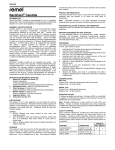
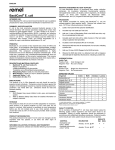
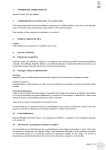
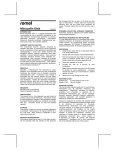
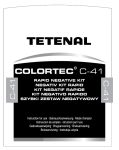
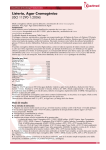

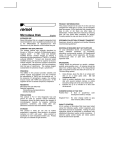
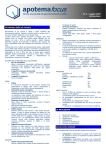
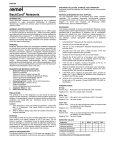
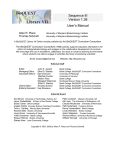
![Strep Grouping Reagents [FR]](http://vs1.manualzilla.com/store/data/006429092_1-0a32c7111f0bdd82229d147ee0a83a65-150x150.png)
